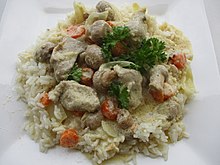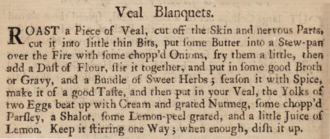Blanquette de veau
 | |
| Type | Stew |
|---|---|
| Place of origin | France |
| Region or state | Normandy |
| Main ingredients | Veal, mirepoix, butter or cream, flour |
Blanquette de veau (French pronunciation: [blɑ̃kɛt də vo] ⓘ) is a French veal stew. In the classic version of the dish the meat is simmered in a white stock and served in a sauce velouté enriched with cream and egg. It is among the most popular meat dishes in France.
Definition
[edit]The Oxford Companion to Food describes "blanquette" as "a French and to some extent international culinary term indicating a dish of white meat (veal, poultry, also lamb) served in a white sauce".[1] In Larousse Gastronomique, Prosper Montagne's definition is "the French term for a ragout of white meat (veal, lamb or poultry) cooked in a white stock or water with aromatic flavourings".[2][n 1]
Simone Beck, Louisette Bertholle and Julia Child in their Mastering the Art of French Cooking describe blanquette de veau, as "a much-loved stew in France … veal simmered in a lightly seasoned white stock … served in a sauce velouté made from the veal cooking stock and enriched with cream and egg yolks".[3] In 2007 Anne Willan wrote that French television had recently conducted a poll of favourite meat dishes in which "Blanquette de veau was in the top five, with steak frites and gigot d'agneau [leg of lamb]".[4]
Ingredients
[edit]The name "blanquette" derives from "blanc", the French word for white, and there is a purist view that the whiteness of the dish is key, and coloured vegetables such as carrots should not be included. In the words of Anthony Bourdain:
Some cooks, such as Anne Willan, share Bourdain's view, but numerous cooks from Auguste Escoffier (1907) onwards have included carrots in their recipes for blanquette de veau, though in many cases the carrot is removed prior to serving.[6]
Beck, Bertholle and Child list six suitable cuts of veal for a blanquette: poitrine (breast), haute de côtes (short ribs), épaule (shoulder), côtes découvertes (middle neck) and gîte/jarret (knuckle).[7] Other cooks and food writers have differed in their recommended cuts for the dish:
| Cook/writer | Recommended cut | Ref. |
|---|---|---|
| James Beard | shoulder | [8] |
| Mary Berry | shoulder | [9] |
| Paul Bocuse | flank and tendron[n 2] | [10] |
| Anthony Bourdain | neck or shoulder | [5] |
| Eugénie Brazier | mixture of breast and collar | [11] |
| Robert Carrier | shoulder or breast | [12] |
| Craig Claiborne | shoulder | [13] |
| Auguste Escoffier | breast, shoulder and collar ribs | [14] |
| Michael Field | leg or rump | [15] |
| Jane Grigson | shoulder | [16] |
| Michel Guérard | shoulder | [17] |
| Edouard de Pomaine | breast | [18] |
| Joël Robuchon | collar, shoulder or knuckle, and either tendron or breast | [19] |
| Michel Roux, Jr. | breast | [20] |
| Louis Saulnier | shoulder or tendron | [21] |
| Anne Willan | shoulder | [4] |
| Clifford Wright | breast | [22] |

In older recipes the veal was roast and allowed to go cold before being sliced or chopped, covered in a white sauce and reheated.[23] Eliza Acton's 1858 recipe includes mushrooms gently sautéed in butter and served over the veal with Sauce Tournée (also called velouté).[24] There was at one time some question of how blanquettes were to be distinguished from fricassées. In 1960 The Times commented:
According to Montagne, blanquette de veau is usually served with rice à la créole but may also be served with celeriac, halved celery hearts, carrots, braised parsnips or leeks, braised cucumber, braised lettuce or lettuce hearts.[2] Pasta or potatoes are sometimes served instead of rice, and Escoffier recommends noodles.[14]
Notes, references and sources
[edit]Notes
[edit]- ^ Montagne adds that blanquette, which had "a very important place in historical cuisine and became a classic of bourgeois cookery" were also made with fish (monkfish) and vegetables (chard and celery).[2]
- ^ In French butchery the tendrons are from the middle of the underside of the animal, between the breast to the front and the flank to the rear.
References
[edit]- ^ Davidson, pp. 80–81
- ^ a b c Montagne, p. 125
- ^ Beck et al, p. 383
- ^ a b Willan, p. 147
- ^ a b Bourdain, p. 142
- ^ Beard, p. 276; Berry, p. 78; Bocuse, p. 77; Brazier, p. 188; Carrier, p. 196; Claiborne, p. 134; Escoffier, p. 692; Field, p. 179; Grigson, p. 205; Guérard, p. 202; Pomiane. p. 225; Robuchon, pp. 156–157; and Roux, p. 150
- ^ Beck et al, p. 381
- ^ Beard, p. 276
- ^ Berry, p. 78
- ^ Bocuse, p. 77
- ^ Brazier, p. 188
- ^ Carrier, p. 196
- ^ Claiborne, p. 134
- ^ a b Escoffier, p. 692
- ^ Field, p. 179
- ^ Grigson, p. 205
- ^ Guérard, p. 202
- ^ Pomiane. p. 225
- ^ Robuchon, pp. 156–157
- ^ Roux, p. 150
- ^ Saulnier, p. 171
- ^ Wright, p. 63
- ^ Francatelli, p. 260
- ^ Acton, p. 273
- ^ "Cookery Glossary", The Times, 1 August 1960, p. 9
Sources
[edit]- Acton, Eliza (1858) [1845]. Modern Cookery, in All Its Branches. Philadelphia: Lea and Blanchard. OCLC 191115250.
- Beard, James (1959). The James Beard Cookbook. New York: Dell. OCLC 1035934036.
- Beck, Simone; Bertholle, Louisette; Child, Julia (2012) [1961]. Mastering the Art of French Cooking, Volume One. London: Particular. ISBN 978-0-241-95339-6.
- Berry, Mary (1972). Popular Freezer Cookery. London: Octopus. ISBN 978-0-7064-0159-2.
- Bocuse, Paul (2002). Les meilleures recettes des régions de France. Paris: Flammarion. ISBN 978-2-08-200929-4.
- Bourdain, Anthony (2004). Anthony Bourdain's Les Halles cookbook. London: Bloomsbury. ISBN 978-0-7475-8012-6.
- Brazier, Eugénie; Moreau, Roger; Bocuse, Paul; Pacaud, Bernard (2015) [2004]. La Mère Brazier: The Mother of Modern French Cooking. Translated by Drew Smith. London: Modern Books. ISBN 978-1-906761-84-4.
- Carrier, Robert (1983). Great Dishes of the World. New York: A & W. ISBN 978-0-89479-134-5.
- Claiborne, Craig (1973). A Kitchen Primer. London: Penguin. ISBN 978-0-14-046172-5.
- Davidson, Alan (1999). The Oxford Companion to Food. Oxford: Oxford University Press. ISBN 978-0-19-211579-9.
- Escoffier, Auguste (1907). Le guide culinaire: aide-mémoire de cuisine pratique. Paris: Colin. OCLC 969508192.
- Field, Michael (1965). Michael Field's Cooking School. New York: M. Barrows. OCLC 1036710870.
- Francatelli, Charles Elmé (1911) [1845]. The Modern Cook. London: Macmillan. OCLC 862897713.
- Grigson, Jane (1975). The Mushroom Feast. London: Penguin. ISBN 978-0-14-046273-9.
- Montagne, Prosper (2001). Larousse Gastronomique. New York: Clarkson Potter. ISBN 978-0-609-60971-2.
- Pomiane, Edouard de (1938). 365 menus, 365 recettes. Paris: A Michel. OCLC 459599801.
- Robuchon, Joël (2011). Dudemaine, Sophie (ed.). La cuisine de Robuchon par Sophie. Paris: Ducasse. ISBN 978-2-84123-334-2.
- Roux, Michel Jr (2009). A Life in the Kitchen. London: Weidenfeld & Nicolson. ISBN 978-0-297-84482-2.
- Saulnier, Louis (1978) [1923]. Le répertoire de la cuisine (fourteenth ed.). London: Jaeggi. OCLC 1086737491.
- Willan, Anne (2007). The Country Cooking of France. San Francisco: Chronicle Books. ISBN 978-0-8118-4646-2.
- Wright, Clifford (2003). Real stew: 300 recipes for authentic home-cooked cassoulet, gumbo, chili, curry, minestrone, bouillabaisse, stroganoff, goulash, chowder, and much more. Harvard Common Press. ISBN 9781558321991.
